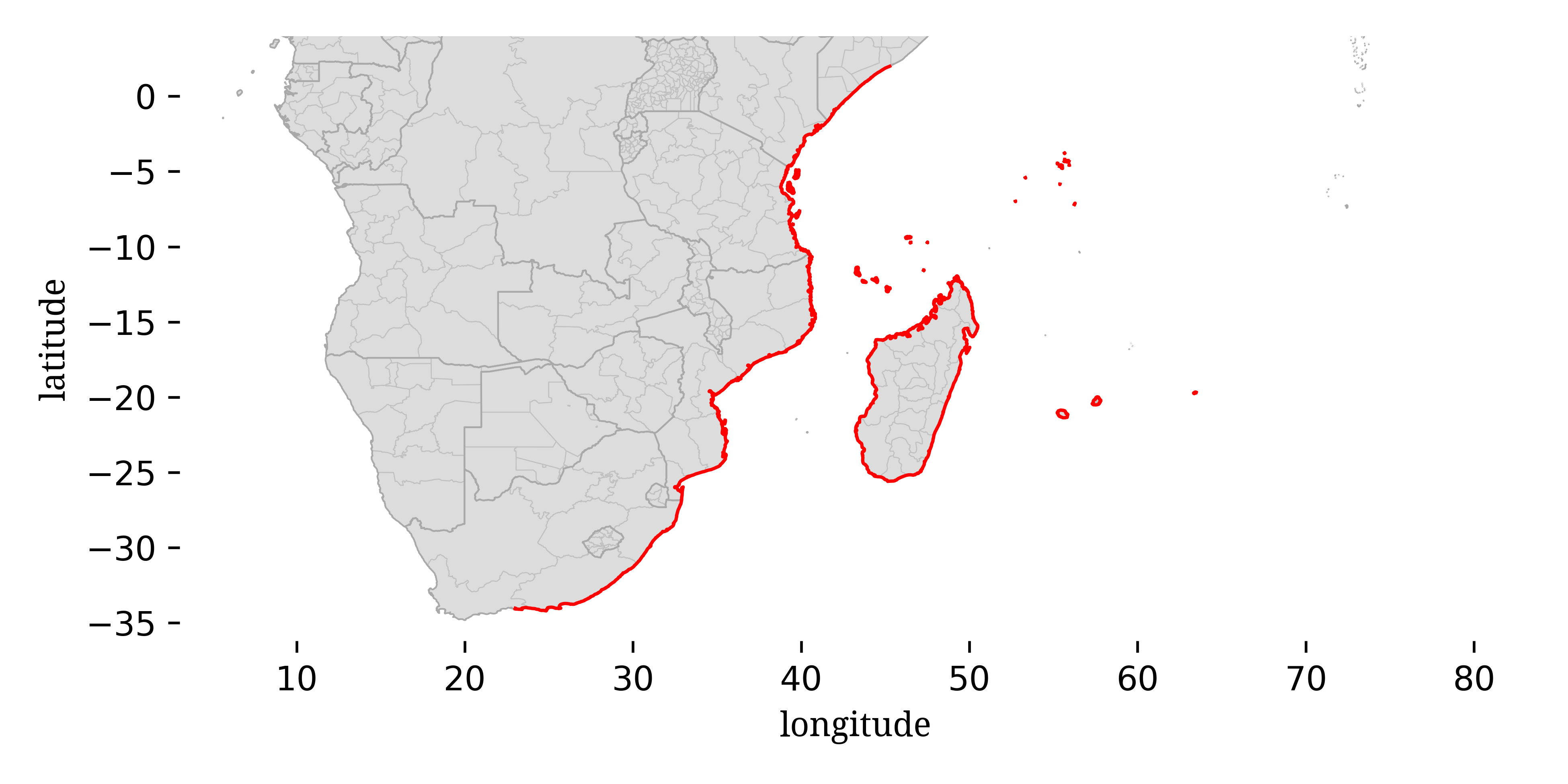
This guide is designed for identification “in the field” where you might be looking at live crabs by eye or through binoculars or from photographs. I will generally try to avoid characters that will require you to physically catch the crab, although I may mention a few for secondary verification. It does not include the more strict taxonomist-style characters that may only be visible under a microscope or via dissection. It is also assumed that the individuals are living, as death (and even capture) can cause dramatic color change.

This is a guide to the fiddler crabs of eastern Africa, from South Africa in the south through southern Somalia in the north, including Madagascar, the Seychelles, Comoros, Mayotte, Mauritius, and Réunion. Six species are found within this region:
A number of features can be used to distinguish among these species, but a good place to start is to look at the distance between the base of the eyestalks. Fiddler crabs tend to split into two groups, those with the eyestalks very close together (“narrow front”) and those with the eyestalks separated a bit more (“broad front”). Three of these species (Austruca occidentalis, Cranuca inversa, and Paraleptuca chlorophthalmus) are broad front species, while the other three (the two Gelasimus and Tubuca urvillei) are narrow front species. The eyestalks of Paraleptuca chlorophthalmus are fairly close together and barely qualify as “broad front”.
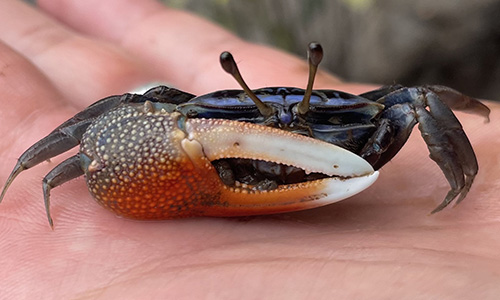
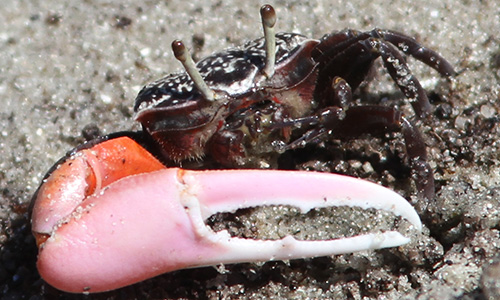
Male Cranuca inversa should be the easiest of any of the species to identify so long as one can get a good look at the large claw. In this species, the tip of the dactyl (the upper finger) on the large claw has a forked shape which is completely unique to this species. Compare the tip of the upper finger of the claw in the “broad front” photo above to those in the four photos below. While the colors of the crabs are very similar, the shape of the tip of the dactyl is distinctly different.
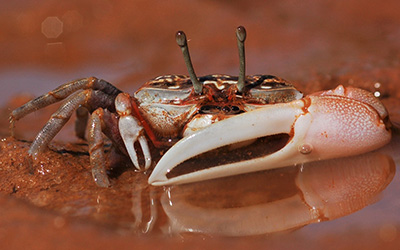
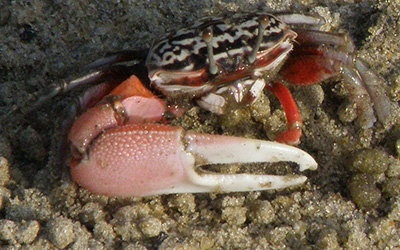
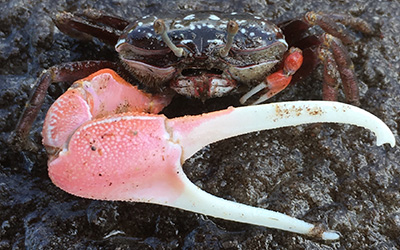
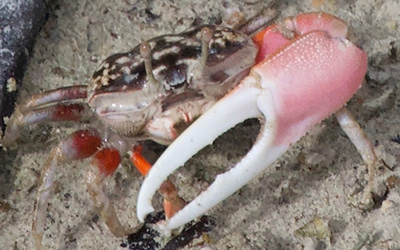
Beyond the shape of the dactyl tip, the “hand” and arm of the large claw tend to be pale pink, while the fingers are usually white. The carapace is generally a mix of black and white, usually—although not always—with more black than white. Unfortunately, this color scheme is very similar to the next species, so without a good view of the claw, it can be very hard to distinguish between them in the field. To my knowledge, there is no reliable way to tell females of the two species apart in the field.
Austruca occidentalis looks a lot like Cranuca inversa. The carapace is predominantly black and white, with more black than white and the claw is often pink. The key feature is that the tip of the dactyl in Austruca occidentalis comes to a more “normal” point rather than the unique fork found in Cranuca inversa. Austruca occidentalis appears to have more color variation, however. In some males the claw is more red or orange rather than pink and the dactyl may be less white and closer to the same color as the rest of the claw. The color pattern of the carapace is subtly different between the two species as well: Austruca occidentalis tends to have smaller, more spotted markings while Cranuca inversa tends to have elongated, more stripe-like markings; you need to be careful in relying on solely on this pattern for identification, however.
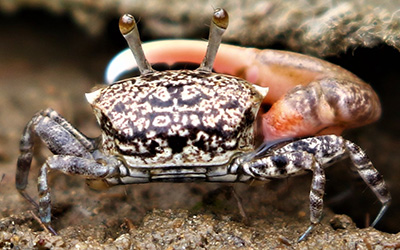
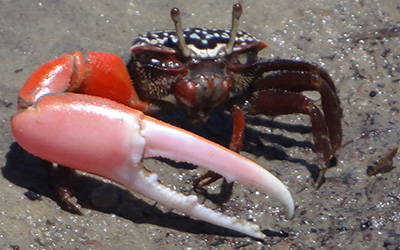
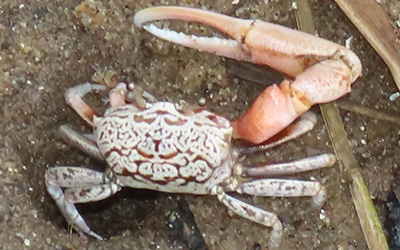
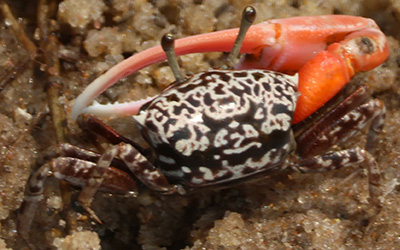
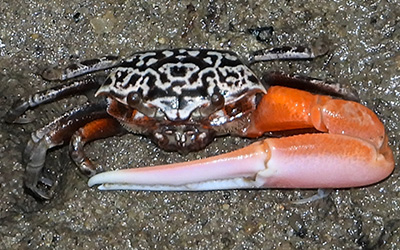
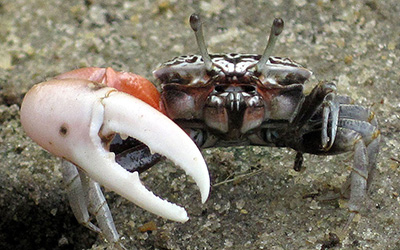
Paraleptuca chlorophthalmus should be readily distinguishable from the other two broad front species because its carapace is predominantly blue with black markings, although sometimes it will be nearly solid one or the other color. Its legs are frequently bright red (although occasionally darkening to almost black), and the large arm and claw tend to be bright red, with only partial whitening on the fingers. The eyestalks are usually yellow-green.
Compared to the previous two species, the large claw tends to appear a bit thicker and heavier, particularly with regard to the shape of the fingers.
For a broad front species, Paraleptuca chlorophthalmus has a relatively narrow front, so much so that the species it is most likely to be confused with is one of the narrow front species, Gelasimus tetragonon, described next.

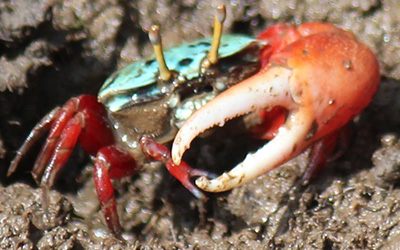
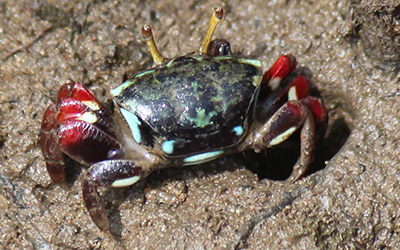
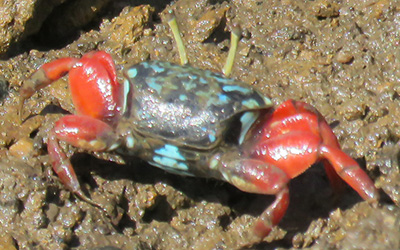
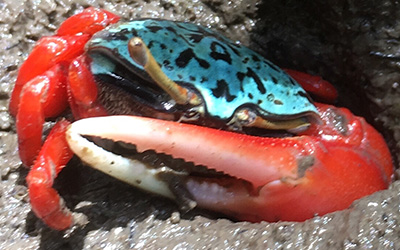
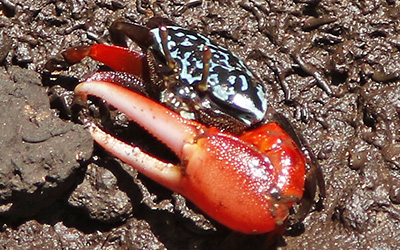
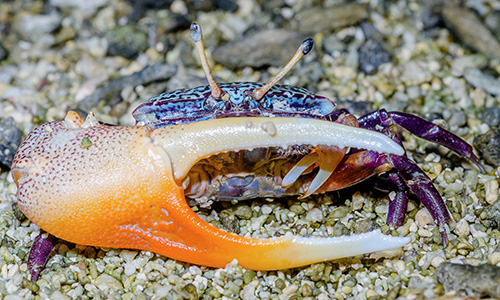
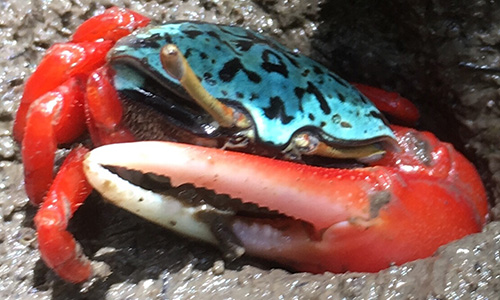
Gelasimus tetragonon is a wide-spread species that can be confused with Paraleptuca chlorophthalmus, despite the latter being a broad front species and the former being a narrow front species, as Paraleptuca chlorophthalmus is a relatively narrow fronted broad front species. Both species have predominantly blue and black carapace and tend to have bright red legs (which occasionally may be darker). Gelasimus tetragonon tends to have gray eyestalks, as opposed to the more yellow-green of Paraleptuca chlorophthalmus.
For males, the large claws of these species tend to be different. While the large claw of Paraleptuca chlorophthalmus tends to be dominated by red, that of Gelasimus tetragonon is more likely to be orange, with a noticeably darker red spot near the base of the pollex. The dactyl of Gelasimus tetragonon is more likely to be mostly white, while in Paraleptuca chlorophthalmus it tends to be more red. Gelasimus tetragonon frequently has brown spots on the top part of the hand of the claw; these spots are never present in Paraleptuca chlorophthalmus.
Gelasimus tetragonon has a lot of additional variability that does not overlap with other local species. In some places the carapace can lighten so that there is almost no blue, just a cream or pale orange with black markings. The pattern of the colors on the carapace can vary from stripes or blotches to tiny spots.
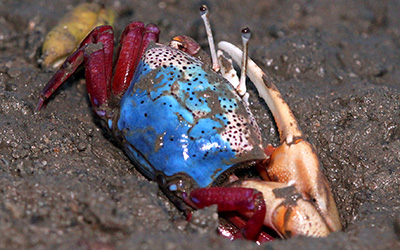
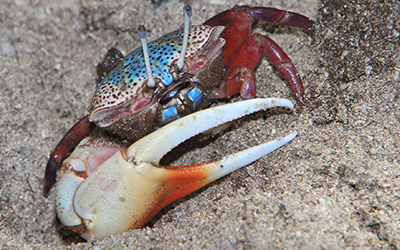
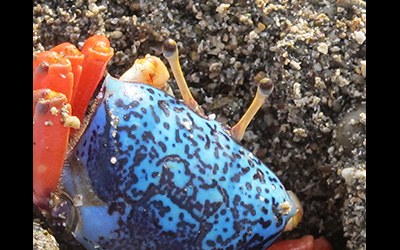
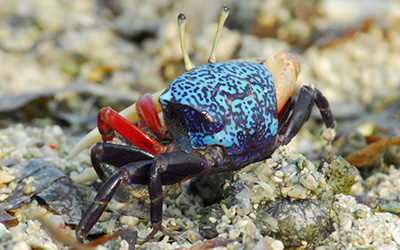
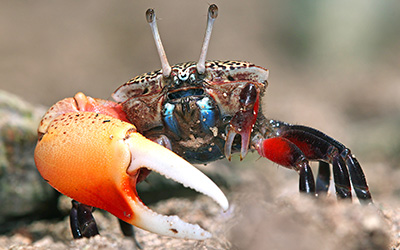
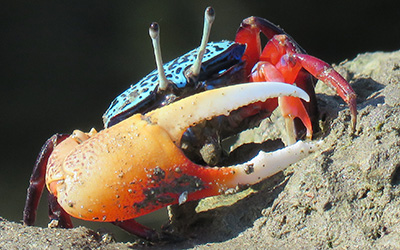
Superficially, Tubuca urvillei may seem similar to the previous two species as it is also a narrow front species with a predominantly dark blue carapace with black markings and a large claw with orange-red and white colors. This superficial description fails to convey some rather striking differences that usually make it easy to pick out from the previous two.
While the carapace of Tubuca urvillei is blue and black, it tends to have less complex patterning and more solid colors relative to the previous two species; in some cases it may appear almost solid dark blue. The shade of blue of Tubuca urvillei tends to be darker, with the other two a bit brighter or aqua, although this is not universal. Tubuca urvillei tends to have black or blue legs, and even if pale, they are never red.
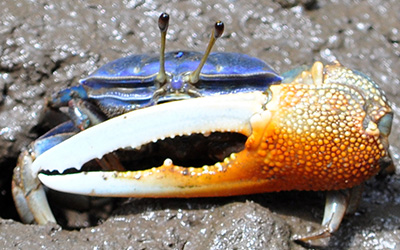
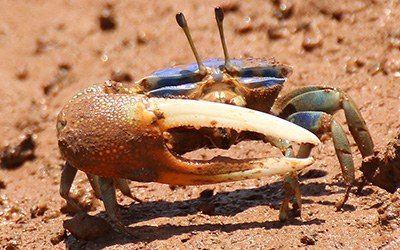
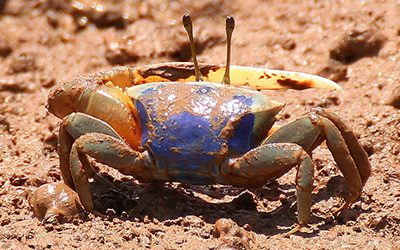

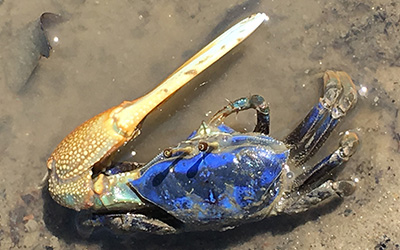
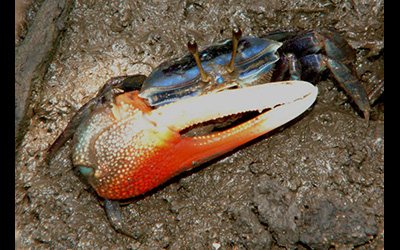
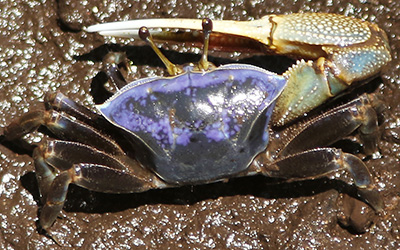
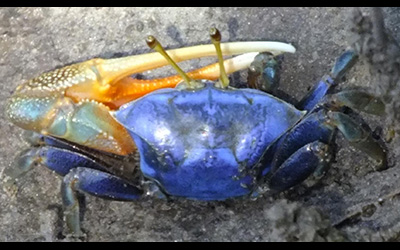
Color-wise the claw of Tubuca urvillei is similar to that of Gelasimus tetragonon with an orange or brown-orange hand, frequently with a darker orange-red patch at the base of the pollex, with the entire dactyl and the latter half of the pollex predominantly white. However, it is structurally somewhat different. Tubuca urvillei has a more robust appearing claw, with clear, large tubercles (bumps) covering most of the outer part of the hand. The fingers are noticeably thicker and tend to be less pointed than the previous species, often having a noticeable flat edge along the lower tip of the dactyl. It may be hard to see through binoculars in the field, but Tubuca urvillei also has a clear deep groove running along much of the length of the pollex. You can particularly see this in the first two photos above.
Gelasimus hesperiae is a narrow front species with a white or pale greenish-brown carapace and a distinctively shaped large claw. It never has any blue and should be readily distinguishable from all of the other species. The dactyl on the large claw is usually white or pink, while the rest of the claw usually ranges from orange to pale yellow. The dactyl is relatively thick and straight for about half its length before clearly curving to a thick point. The pollex will frequently have two very clear large teeth, one about midway along the length and one near the tip, although one or both can be absent. Like Tubuca urvillei, it has large bumps (tubercles) on the hand of the claw and will often have a noticeable groove along the base of the pollex.